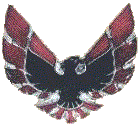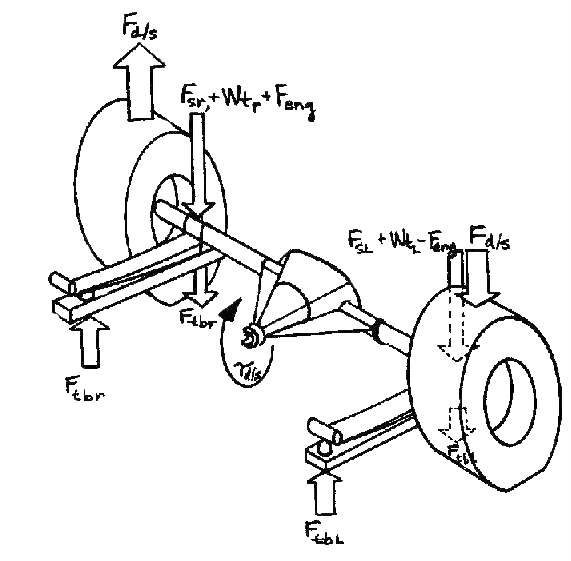
 |
Leaf Spring Traction
|  |
 Wallace Racing
Wallace Racing
 BACK to Tech Articles
BACK to Tech Articles
This is taken from H-O Racing's High Output newsletter -Jan. 1975
TECHNICAL
TOPIC: Drag Racing
Leaf-Spring Rear Suspensions
Most
racers have more performance potential in their Pontiac than they realize simply because they are not getting all their
available power to the ground for maximum acceleration. Even though your drag
racing Pontiac is leaving "straight" both rear tires may not be
pulling with maximum tractive force or even equally: Therefore the subject of this Technical Topic is a simple analysis of the forces and
torques acting on the rear suspension and
how to compensate for the various unequal forces on a leaf-spring Pontiac such as a Firebird or Ventura
II.
Below
is a sketch of a typical leaf-spring suspension with traction bars. The
forces acting on each rear wheel and the "upsetting" force due to the driveshaft torque are
illustrated.
Forces
on the right tire (passenger side) are:
Fr- Far + Wtr
+ Feng - Fd/s + Ftbr
Forces on the left tire (driver side)
are:
Fl
- Fsl + Wtl -
Feng + Fd/s + Ftbl

The
terms above are:
Fsr = force the right spring exerts on the axle housing (spring rate times deflection)
Fsl = same as Fsr, but for left side
Wtr = Weight on the right side
due to uneven loaded weight (driver, etc.)
Wtl = same as Wtr, but for left side
Feng = Force on the
chassis due to engine torque (engine torque divided by half the distance between spring
perches)
Fd/s
= Force on the rear axle due to
driveshaft torque (engine torque times transmission gear ratio divided by half the distance between rear tires)
F tbr = Force
exerted upon the chassis and down on the right side of the axle
by the traction bar (coefficient of tire friction times half the driveshaft torque times rear
end gear ratio divided
by the distance from the axle centerline to the traction bar snubber)
Ftbl=
same as Ftbr but for
the left side
The ideal
situation is when the
forces on both wheels
are equal. To figure out how to get this ideal situations we have to know the
contribution of each of the terms in the above formulas and adjust them accordingly. Let us look at an example and see how unevenly the
tires are loaded in a typical situation. A 1973 Firebird Trans
Am 455 Super Duty weighs about 3640. About 45% of the
static weight is on the rear wheels so the
force due to the rear springs (equal spring rates in this case) is
819 lb on each side. An average driver weight is 180 lb. About 60% of his weight is on the driver side and about 45% of that weight is on the rear
wheels, so the uneven weight is 45 lb on the left side, 32 lb on the right side. A typical 455 SD engine torque value is 400 ft-lb.
The
resultant chassis force due to engine torque is 213 1b (400 x
2/3.75). The resultant axle force due to driveshaft
torque is 389 lb (400 x 2.43 x 2/5) . Adding
everything up (with no traction bars considered) yields:
Force Left
Side Right Side
Spring 819
lb 819 lb
Uneven weight 49
32
Engine Torque -213
213
Driveshaft torque 389 -389
Total 1044lb 675 lb
We
see that without traction bars we are unevenly loaded by 369 lbs: If we are clever in our traction bar and tire
adjustment, we can compensate for most of this. Referring back to the
description of the force due to the traction bar, we note that both the
coefficient of tire friction and the traction bar snubber distance are
adjustable. Most traction
bars such as JR Action Bars have
provision for locating the snubber in one of two locations. The longer location (22") is used
on the left side and the closer one (20") is used on the right side. If
the coefficient of tire friction is 1.0, then the
resultant left traction bar force is 1211 lbs (1 .0 x 400 x 2.43 x .5 x
4.56/1.83) and the resultant right traction bar force is 1327 lbs (1.0 x 400 x
2 .43 x .5 x 4.56/1.67) . The net difference is only ll6 lbs, so the Trans Am will still
not be equally loaded but
should run much quicker
mostly because of
the added tire loading provided by the traction bars (2538 lb total).
If
we raise the pressure of the left side slick, it will reduce the coefficient of
friction and the traction bar force. If we assume a coefficient of 0.79, the
resultant left traction bar force will be 958 lb (instead of 1.211 lb) with a
net difference of 369 lb compared to the right traction bar. This results in
equal force on each tire, but unequal traction since the coefficient of
friction is different for each tire since traction force equals coefficient of
friction times tire loading force. If we lower the tire pressure in the left
slick back towards its initial value to raise its coefficient of friction, we
will eventually hit upon a coefficient value that results in equal traction. In
this case the value is 0.925 for the left tire and 1.0 for the right tire. The
resultant forces are:
Force
Left
Side
Right Side
Previous forces
1044
675
Traction Bar force
1120
1327
Total
2164
2002
Times coefficient of friction x0.925
x1.000
Traction force
2002
2002
The
Trans Am will be quicker yet, but still not at maximum potential since the left
slick is working at less than maximum traction.
If
we add spring force (stiffer spring, air lift bag, air shock, etc) to the right
side and lower the left slick air pressure back to maximum
traction value, the best traction situation will result. In this case, it takes
253 lb (1044 + 1211 - 2002) difference in spring force. Loading the right
tire with spring force unloads the left one the same amount since total vehicle
weight is unchanged. Therefore if we add 127 (253/2) spring force to the right
side, the resultant traction forces are:
Force
Left
Side Right Side
Spring.
692 946
Uneven weight 49
32
Engine torque
-213 213
Driveshaft torque 389
-389
Traction Bar
1211
1327
Total
2128
2129
This
set-up provides the maximum downward force on the tires (4257 lb) and
although it is less than the maximum available acceleration force of 5540 lb
(400 a 2.43 x 4.56 x 1.25), in actuality, chassis reaction due to the acceleration
will provide additional spring force to increase the acceleration force and
tend to keep the chassis level in the rear (keep the rear end from jumping up
due to traction bar reaction). In any case, now you know how to go about
getting that hole-shot on the competition!

